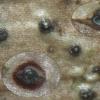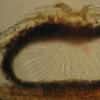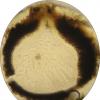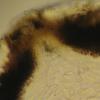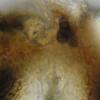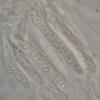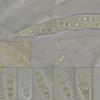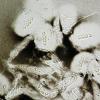
20-01-2026 17:49
 Hardware Tony
Hardware Tony
I offer this collection as a possibility only as e

15-01-2026 15:55
 Lothar Krieglsteiner
Lothar Krieglsteiner
this one is especially interesting for me because

17-01-2026 19:35
Arnold BüschlenHallo, ich suche zu Cosmospora aurantiicola Lite

16-01-2026 00:45
Ethan CrensonHi all, On decorticated hardwood from a New York

18-01-2026 12:24
Hello.An anamorph located on the surface of a thin

08-12-2025 17:37
 Lothar Krieglsteiner
Lothar Krieglsteiner
20.6.25, on branch of Abies infected and thickened
Massarina microcarpa
Alain GARDIENNET,
16-02-2013 14:46
Dear all,
Je vous propose ici une récolte faite sur Rubus :
Ascomata 300-350 µm diameter, coming under periderm of Rubus, peridium 25-40 µm thich, composed of polyhedrical cells. Ostiolar pore cylindrical 40-60 µm of diameter.
Hamathecium composed of hyalin trabeculous pseudoparaphyses, 1 µm.
Asci : bitunicate, cylindrical, 60-80 x 9-11 µm.
Ascospores 1-3 septate, hyalin, strongly constricted at the primary septum,ellipsoidal +/- conical, mucous sheath 1 µm (up to 2,5 µm), 16-19 x 4,5-5,5 µm.
After thinking to Keissleriella cladophila, the ostiolar setae lacking, I have searched in Massarina. I think it could be Massarina microcarpa. But I note that Massarina rubi is very closed (could they be synonymous ?). But as the first one is given with 1-3 septate ascospores, and according to all precedent features, I think it could be the one called Massarina microcarpa by some authors like Boose.
If I can have your opinion...
Alain
Alain GARDIENNET,
17-02-2013 08:44
Re : Massarina microcarpa
Dans la littérature, seul Boose parle suffisamment de ce taxon.
Je note aussi que M.E. Barr cite l'asymétrie des ascospores (Mycotaxon 55, 1992).
Si quelqu'un a une autre référence sur ce taxon, je suis preneur.
Alain
Je note aussi que M.E. Barr cite l'asymétrie des ascospores (Mycotaxon 55, 1992).
Si quelqu'un a une autre référence sur ce taxon, je suis preneur.
Alain
Ying Ying Zhang,
17-02-2013 10:13
Re : Massarina microcarpa
Hi Alain,
Is it from freshwater? If so, Mycologia 102: 729-746 helps for identification. Or else, it might closely related to Lophiotrema.
Cheers
Ying
Is it from freshwater? If so, Mycologia 102: 729-746 helps for identification. Or else, it might closely related to Lophiotrema.
Cheers
Ying
Alain GARDIENNET,
17-02-2013 10:36
Re : Massarina microcarpa
Hi Ying,
Sorry, I didn't say but it's not from freshwater.
I excluded Lophiotrema because of the cylindrical short ostiolar neck.
It's the reason why I searched at last around the terrestrial species in the genus Massarina like rubi, microcarpa, polymorpha, salicinicola ... Host is Rubus.
After comparison, M. microcarpa is the better one, I think.
I can put a piece on the side for you, if you want.
Thanks,
Alain
Sorry, I didn't say but it's not from freshwater.
I excluded Lophiotrema because of the cylindrical short ostiolar neck.
It's the reason why I searched at last around the terrestrial species in the genus Massarina like rubi, microcarpa, polymorpha, salicinicola ... Host is Rubus.
After comparison, M. microcarpa is the better one, I think.
I can put a piece on the side for you, if you want.
Thanks,
Alain
Ying Ying Zhang,
17-02-2013 11:08
Re : Massarina microcarpa
Hi Alian,
I agree with you that this speicies looks like M. microcarpa. As based on molecular work, Massarina is polyphyletic, and only few ones kept in Massarina sensu stricto. Some of those terrestrial ones should be put in the clade XIV (studies in mycology, vol 64. 85-102). It is a big clade, and might include several families. But at this moment, we can not separate them. Yes, please could you send me the specimen--then I will isolate it.
please let me know if you need these publications mentioned.
Cheerio
Ying
I agree with you that this speicies looks like M. microcarpa. As based on molecular work, Massarina is polyphyletic, and only few ones kept in Massarina sensu stricto. Some of those terrestrial ones should be put in the clade XIV (studies in mycology, vol 64. 85-102). It is a big clade, and might include several families. But at this moment, we can not separate them. Yes, please could you send me the specimen--then I will isolate it.
please let me know if you need these publications mentioned.
Cheerio
Ying
Alain GARDIENNET,
17-02-2013 11:33
Re : Massarina microcarpa
Ok, I will send it to you.
Thanks for all.
Alain
Bernard Declercq,
17-02-2013 12:12

Re : Massarina microcarpa
Hi Alain,
To me, spore form and dimensions, and even substrate, may suggest Massarina polymorpha. Why you excluded this possibility?
Bernard
To me, spore form and dimensions, and even substrate, may suggest Massarina polymorpha. Why you excluded this possibility?
Bernard
Björn Wergen,
17-02-2013 12:12

Re : Massarina microcarpa
Hi Ying,
can you please send me this article (Mycologia 102)? It would be interesting for me.
regards and thanks,
björn
can you please send me this article (Mycologia 102)? It would be interesting for me.
regards and thanks,
björn
Alain GARDIENNET,
17-02-2013 13:41
Re : Massarina microcarpa
Salut Bernard,
M. microcarpa et M. polymorpha (et aussi M. salicinicola d'ailleurs) sont très proches. J'ai beaucoup d'attente au niveau de la biomol pour éclaircir ce point.
J'ai opté pour microcarpa, en comparaison avec polymorpha, pour deux raisons. La première est la forme des spores qui, selon Boose, ne serait pas fusoïde chez polymorpha. Or, dans ma récolte un bon nombre l'est (on en voit sur ma photo mais j'en ai bien d'autres). La seconde est le substrat : Rubus. M. polymorpha est donné exclusivement sur Rosa, alors que Rubus est un des hôtes déjà signalé pour microcarpa.
J'ai peut-être sur la liste de mes récoltes à travailler, un Massarina sur Rosa. S'il s'avérait que ce soit polymorpha, je pourrais alors comparer et bien entendu j'en tiendrai informé le forum.
Amitiés,
Alain
M. microcarpa et M. polymorpha (et aussi M. salicinicola d'ailleurs) sont très proches. J'ai beaucoup d'attente au niveau de la biomol pour éclaircir ce point.
J'ai opté pour microcarpa, en comparaison avec polymorpha, pour deux raisons. La première est la forme des spores qui, selon Boose, ne serait pas fusoïde chez polymorpha. Or, dans ma récolte un bon nombre l'est (on en voit sur ma photo mais j'en ai bien d'autres). La seconde est le substrat : Rubus. M. polymorpha est donné exclusivement sur Rosa, alors que Rubus est un des hôtes déjà signalé pour microcarpa.
J'ai peut-être sur la liste de mes récoltes à travailler, un Massarina sur Rosa. S'il s'avérait que ce soit polymorpha, je pourrais alors comparer et bien entendu j'en tiendrai informé le forum.
Amitiés,
Alain
Jacques Fournier,
17-02-2013 16:41

Re : Massarina microcarpa
Hi to all and welcome to Ying on this forum!
If it can help, I attach a photo of ascospores of what I called Massarina rubi mounted in India ink. The mucilaginous sheath is wide, but not easily made out in water. But it might have been M. microcarpa too!
Alain, you report trabeculate pseudoparaphyses, are they wide and cellular or thin and mostly aseptate? To fit Massarina they should be of the first type.
Good luck with these tricky genera!
Jacques
If it can help, I attach a photo of ascospores of what I called Massarina rubi mounted in India ink. The mucilaginous sheath is wide, but not easily made out in water. But it might have been M. microcarpa too!
Alain, you report trabeculate pseudoparaphyses, are they wide and cellular or thin and mostly aseptate? To fit Massarina they should be of the first type.
Good luck with these tricky genera!
Jacques
Alain GARDIENNET,
17-02-2013 18:08
Re : Massarina microcarpa
Salut Jacques,
C'est une mission bien difficile que de déterminer un Massarina.
Je tenais à montrer cette récolte dans le but qu'elle puisse servir à mieux les comprendre ; L'envoyer à Ying va donc dans le bon sens.
J'avais moi aussi rencontré M. rubi (qui doit être dans cette base). Les spores sont différentes comme on peut le voir avec ta photo. Plus symétriques chez rubi. La gangue est moins spectaculaire aussi.
J'avais noté au sujet de mes paraphyses : trabéculaires. Je n'ai pas de photo qui le rend bien mais ce sont des paraphyses de 1 µm à la base qui alors peuvent être cloisonnées et qui s'effilochent aux extrémités.
A+
Alain
C'est une mission bien difficile que de déterminer un Massarina.
Je tenais à montrer cette récolte dans le but qu'elle puisse servir à mieux les comprendre ; L'envoyer à Ying va donc dans le bon sens.
J'avais moi aussi rencontré M. rubi (qui doit être dans cette base). Les spores sont différentes comme on peut le voir avec ta photo. Plus symétriques chez rubi. La gangue est moins spectaculaire aussi.
J'avais noté au sujet de mes paraphyses : trabéculaires. Je n'ai pas de photo qui le rend bien mais ce sont des paraphyses de 1 µm à la base qui alors peuvent être cloisonnées et qui s'effilochent aux extrémités.
A+
Alain


